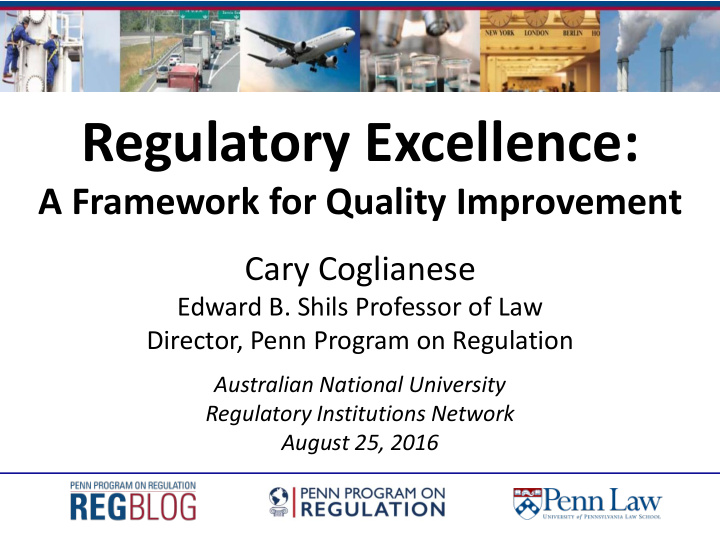



Regulatory Excellence: A Framework for Quality Improvement Cary Coglianese Edward B. Shils Professor of Law Director, Penn Program on Regulation Australian National University Regulatory Institutions Network August 25, 2016
We See Signs of Regulatory Failure Explosion of Deepwater Horizon, April 2010 Photo source: US Coast Guard
But What Does Regulatory Success Look Like?
Best-in-Class Regulator Initiative: Outputs Sponsored by the Alberta Energy Regulator
Three Key Issues 1. Attributes of Regulatory Excellence 2. Becoming (or Remaining) an Excellent Regulator 3. Measuring for Regulatory Excellence
What Makes for an Excellent Cellist?
What Makes for an Excellent Regulator? Photo sources: U.S. Nuclear Regulatory Commission
Strategic Plans Study • Conducted by Adam Finkel, Daniel Walters, & Angus Corbett • Backward induction • 20 strategic plans • Regulators from 9 different countries • Australia • Norway • Canada • South Africa • Ireland • United Kingdom • Japan • United States (state & federal) • Mexico • Identified 25 attributes across 7 categories
Strategic Plans Study Category % Plans Efficient 90% Synergistic * 85% Effective ** 80% Proportional 75% Educative 60% Just 55% Honest 40% Source: Finkel, Walters & Corbett (2015) * Their label is “multiplicative” ** Their label is “vital”
Selected List of Attributes of Regulatory Excellence Source: Appendix B to Cary Coglianese, Listening and Learning: Toward a Framework of Regulatory Leadership (2015)
Source: Coglianese & Scheffler (2016)
RegX: Atoms of Excellence
Nine Tenets of Regulatory Excellence
Regulatory excellence applies to a regulator’s …. T raits (as organization) A ctions O utcomes (Or the TAO of Regulatory Excellence….)
Becoming an Excellent Regulator: A Model of Regulatory Performance
Becoming an Excellent Regulator : A Model of Regulatory Performance Key Ways to Become Excellent
What are the Key Ways to Become an Excellent Regulator? People (Internal Management) Mission Autonomy Resources Culture Human capital Priority-setting E.g., risk-informed Problem-solving Rule-making Rule-application (enforce- ment, licensing) Incident response Public (External Engagement)
Achieving Regulatory Excellence Will Mean Making Choices • How to define your regulatory mission? • How to allocate resources? • How to design rules? • How to respond to rule violations? • How to engage with the public?
Example: What Does “Risk - Based” Mean? Target biggest hazard? A Target biggest risk? C Avoid excessive costs? C or D Avoid unacceptable risk? B, C, or D Hippocratic principle? C or D Maximize net benefits? D
Infuse Regulatory Excellence Throughout Your Performance Model
Excellence Infusion
Measurement and Excellence • Measurement serves many purposes. The most important is to learn . • Distinguish between…. Measurement for regulatory excellence versus Measurement of regulatory excellence
Make Measurement Strategic
Choose metrics that are … • Relevant • Related Measure with • Tight excellence too: • Reliable integrity, • Accurate competence, • Resistant • Realistic engagement…. • Available • Intelligible
Methods of Measurement 1. Actions (bean-counting) 2. Outcomes (stock-taking) 3. Action Outcomes (causation) Note: Avoid linking measurement to organizational incentives. Remember, the most important reason for measurement is to learn!
Excellence in Everything! Align strategic priorities around RegX Align organizational culture around RegX Build human capital around RegX Involve public in pursuit of RegX Use strategic measurement for RegX
Next Steps Toward Regulatory Excellence 1. Self-awareness : build out the model 2. Scoping : assess current alignment with RegX 3. Select strategic priorities : identify key areas to improve 4. Assessment and continuous improvement: measure and move forward!
Recommend
More recommend